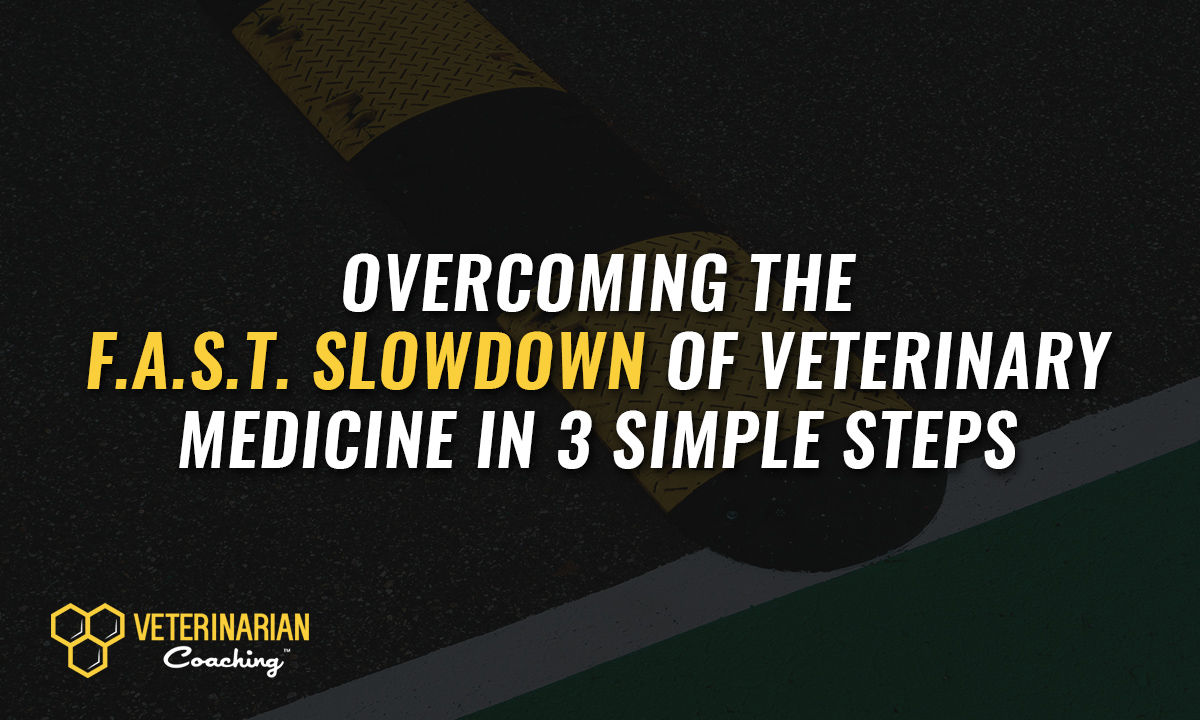27, 2019

Overcoming the F.A.S.T. Slowdown of Veterinary Medicine in 3 Simple Steps
If we drive too fast, ultimately something will slow us down, be it a bump or curve, your brakes, or even the police.
If we run too fast for too long, our body will slow us down via depletion of muscle glycogen or oxygen uptake.
The Veterinary Industry is on track for a F.A.S.T. slowdown. What is going to slow the veterinary industry? F.A.S.T. is what, and it’s coming faster than we think. F.A.S.T. stands for Fear, Anxiety, Stress, and Trauma.
Veterinary Professionals are experts at seeing and managing fear, anxiety, stress and trauma in animals; unfortunately, they aren’t experts at seeing them within themselves or their colleagues.
Many are so blinded by F.A.S.T. that they can barely see to the end of their day … much less their month or year! They are in white-knuckle survival mode. While in survival mode, you don’t get to enjoy your career, much less other parts of your life.
F.A.S.T. is a negative feedback loop that creates a “mental vortex” of trauma and stress leading to fears and anxiety, which then leads to poor sleep and recovery, which leads to increased anxiety, which feels even more stressful, which accumulates into more traumas. The cycle continues to repeat and grow often times takes your sanity with it.
If you can slow down now, before it’s forced upon you by F.A.S.T., you will move from survival mode to striving for more out of life and finally into thriving within this industry.
In order to break the “mental vortex” we have to make the unconscious/subconscious brain feels “safe”. So how do we help this part of the mind feel safe? Just like we do with an animal, we back the pressure off, we change the scenery, and change the pattern. We will shift from prey to predator mode (i.e. shift from sympathetic to parasympathetic dominance).
Before we go through these steps we want you to assess if you’re dealing with any F.A.S.T. slowdowns. If so, bring those feelings to the forefront and rate them on a scale of 0 – 10, where 0 is no feelings and 10 is the worst. Write that number down. Now it’s time to shift out of that prey mode and get control of your inner predator, in three simple steps:
- Lift/hold your head high and pull your shoulders back. This exposes the neck and head and opens the ribs for the “hunt.”
- Take a breath in through your nose for a count of 4 and exhale through pursed lips for a count of 8. Feel your abdomen and ribs expand as you do this. Repeat this 5 times. This lowers your heart rate and stimulates the vagus nerve.
- Now pick out a point 8-12 inches above your line of sight and focus intently on it. While continuing to look at that point, soften your vision and expand your peripheral vision as far as you can (as if you were able to see behind you) then bring your focus back to the point you focused on before, then soften and go back to your peripheral vision, take it farther than you did the first time. Now blink! This takes your intensity off of the single thought and allows you to see other perspectives and opportunities.
https://youtu.be/cADGTU6cfTw
Ok, now find those same F.A.S.T. feelings you had before doing these 3 steps and rate them again. How much did your number drop?
If your number dropped but it’s not yet to a zero or one, repeat the 3 steps above, rating your F.A.S.T. feelings before and after. Welcome to the world of neuroplasticity! You are now interrupting the pattern of F.A.S.T. When you continue to practice this you’re going through a process called synaptic pruning.
This causes the F.A.S.T. synapses that were firing before to begin to die off. The more you practice, the more you prune. Is it really that simple? It can be. Like anything else, the full answer is “it depends” and there are more advanced techniques that may need to be used, but this process hits all the points in our analysis triangle.

- Is it Effective? Yes!
- Is it Efficient? Yes, It can be done in less than 30 seconds.
- Is it Simple? Maybe too simple, but 3 steps is pretty simple.
- Can it be done consistently? Yes, the beauty of this technique is that it can be done any time, any place, and no one even has to know you’re doing it.
Why does this work? When we are stressed and feeling “hunted” we tuck our heads down to make ourselves smaller, breathe faster and more shallow, and get tunnel vision to focus on the predator. As you can see, these steps turn the table on predator and prey body language.
Does this process solve all of the problems in Veterinary Medicine? No, but it’s a useful start. Meditation and Mindfulness are awesome, going for walks and working out are great, eating better foods and “disconnecting” from the digital world sound wonderful, but we need a simple place to start and grow from.
If you want to learn other techniques that are even more effective, or you need some help with other things, let us know and we will schedule a time to talk.
P.S. Whenever you’re ready… here are a few ways we can help you grow in your personal and professional life:
- Join The Modern Veterinary Professional (MVP) Group and connect with other veterinary professionals who are growing and scaling their life and career. This is our Facebook community where Modern Veterinarian Professionals learn to have more income, impact, and freedom. — Click Here
- Join our Modern Veterinarian Coaching Program and be part of Case Study Group. We are putting together a new coaching case study group at Veterinarian Coaching next month… stay tuned for details. If you’d like to work with us on your life and career… just click here and put “Case Study” in the message.
- Work with us privately. If you’d like to work directly with us to take you from where you are to where you want to go … Click here and put “Private” in the message… tell us a little about your career and what you’d like to work on together, and we’ll get you all the details!

